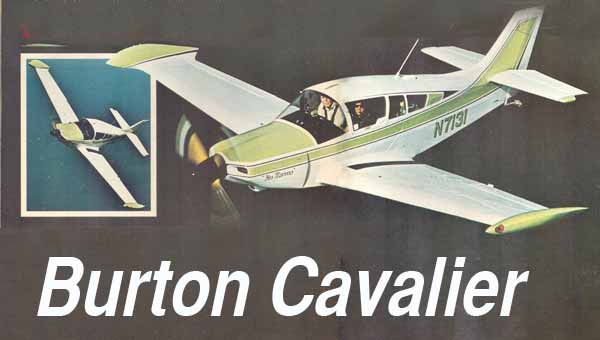
 |
Larry Burton's 160mph
Wooden Wonder |
When Good Isn't
Enough |
PAGE TWO
The two-finger approach worked on all the controls and let me experience the airplane's slippery, silky control reaction. As with most planes of its size, control response is pronto, no lag, no inertia hang-up, no nothing. But at the same time, it is very, very precise. You can whip a wing up and bang into a 60 degree bank like you were a Blue Angel flying the landing break, and the controls let you stop it at the exact degree of bank you want. At 2400 rpm we were indicating a pretty solid 150-155 mph (160 TAS), which Burton says takes about 6 gph. With 24 gallons on board that gives him an absolute range of 640 miles, no reserve. Clean stalls were about as you'd expect, with the exception that it feels as if it really doesn't have enough elevator to hold it stalled, so it just sort of mushes. Gear and flaps down, it breaks much more cleanly with a fairly pronounced roll in one direction or the other. All of this is happening down around 50 mph, so it's no lunch eater. In the pattern, all dirtied up, it did nothing that you wouldn't expect from a piece of factory iron. Even on final you could have made pretend it was a Bonanza/Arrow/Swift and made an absolutely perfect approach. The only place you'd have to watch your-self is in the actual flare. That little hummer sits so low to the deck that there's not only a tendency to flare a bit high, but it's easy to over-rotate as well. At no time does the runway disappear, not even when flaring, so I did just as I'd told myself not to do, I rotated a bit too much and got it on tailwheel first, as if I were a Corsair jockey looking for number three wire. It tiptoed from gear to gear just a bit and settled down to follow what my feet were telling it to do. Aside from some reference problems which resulted in my eyes giving me the wrong info about how high my butt was off the runway, it was a very, very straightforward, easy to fly airplane. It's a credit to the basic design and to the modifications that Burton made that it fits together so well. I suppose I should probably mention that I had originally intended to fly two Cavaliers, Burton's R.G. job and Verne Minzimer's '76 Grand Champion 102.5, but I somehow never got to catch Verne before he split for parts unknown (The So-Cal hinterlands). Both Burton's and Minzimer's are unreal examples of what regular people-type persons can whittle out in their garages. Also, I wanted see how a nearly stock Cavalier flies. The Cavalier 102.5 is really nothing more than the old 1946 French Minicab cleaned up to use modern ideas of structures, materials and aesthetics. In terms of appearance, not much of the old Minicab remains. The Mini looked like a homebuilt Culver Cadet, which is to say it was a project, which took a lot of time and turned out ugly. The Cavalier modification sought to remedy the uglies. Even so, the Cavalier still has a cabin roof line that looks as if it was designed for pilots with pointed heads. Most Cavalier owners lower and streamline the cabin lines similar to the way Burton did on his. The original Cavalier is sort of unique in that it's designed to be either a tri-gear or a taildragger or both. Supposedly you could build in two sets of gear mounts so you could fly it on Saturday with the nose wheel and, if anybody called you a limp wrist for flying a tri-gear, you could return on Sunday with a tailwheel, using the same gear legs and all. At designed gross weight of 1500 pounds (890 empty) the stock Cavalier with tip tanks (24 gallons) carried about 12 pounds per square foot of wing. Burton's weighs 1100 pounds empty, so he's at a natural disadvantage in that area, but the cleaned up belly ought to make up for it. As it happens, most Cavaliers weigh 1000 pounds or more. Burton's gear mod required extensive rehashing of the inner wing panel to accommodate the T-33 hatch motor operated actuating system and the Czechovic CA-65 legs. He's drawn up plans for the unit and is currently trying to sell a few to make back some of the costs of building "Mistress."
That's always been the way with homebuilts, the more traditional ones anyway. You cart a surprisingly expensive stationwagon-load of lumber into your garage and years later, when the wrinkles around your eyes and the greying at your temples mark the passage of an inordinate amount of time, you tow the same lumber back out of the garage. This time it moves tail first, on its own wheels, out to the airport to feel out an entirely new environment . . . the sky. Homebuilding is not quick, it's not easy and the results are often no longer suited to the builder. A man ages and his tastes change. An airplane is constant. So, the young man who may have wanted a zippy, tail-twisting biplane finds the man/machine match no longer dovetails. He now needs something a little more sedate/faster/ prettier/bigger. He needs something, which fits his changed tastes, whatever they may be. With Larry Burton, when his airplane was done, he was a little older, a little greyer, just like the rest of us, but the dove-tail still matched. The spruce and fabric he'd laboriously loved for those years were still what he wanted. The Cavalier was still close to being the perfect airplane for him, it was still a material statement of an aerial emotion. It was, after all, not by accident that he named it "His Mistress." BD |